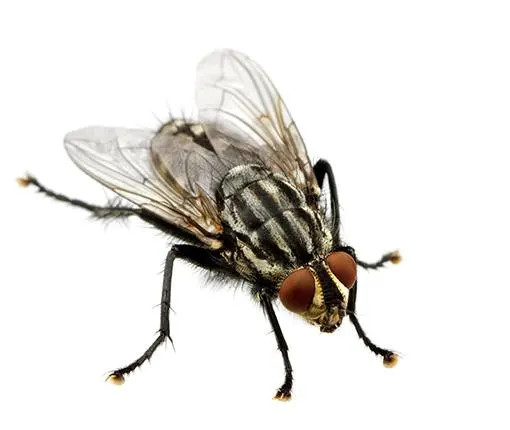Flies are more than just a buzzing annoyance; they’re unhygienic pests that can spread diseases. These resilient insects, often breeding in less-than-pleasant environments like decaying food and waste, can quickly become a significant problem in your home. Understanding how to effectively and safely get rid of flies is crucial for maintaining a healthy and comfortable living space.
This guide will walk you through proven methods to not only eliminate flies currently buzzing around your house but also prevent future infestations. From simple DIY traps to natural remedies and preventative sanitation tips, you’ll gain the knowledge to reclaim your home from these unwelcome guests.
 A common housefly perched on a window screen, illustrating the challenge of keeping flies out of homes.
A common housefly perched on a window screen, illustrating the challenge of keeping flies out of homes.
Effective Fly Control Strategies
A comprehensive approach to fly control starts with addressing the root causes of infestation: sanitation and exclusion. Once these foundational steps are in place, you can enhance your fly-fighting arsenal with a range of solutions, from targeted insecticides to natural, eco-friendly options.
Integrated Fly Management Techniques
The best strategies for managing flies combine prevention with active control. This integrated approach involves:
- Sanitation: Eliminating breeding grounds is the most crucial step.
- Exclusion: Preventing flies from entering your home in the first place.
- Trapping and Killing: Using various traps and insecticides to remove existing flies.
For those seeking immediate solutions and ongoing management, a variety of products are available, including:
- Insecticide Concentrates: For broader application in problem areas.
- Insecticide Dusts: Effective in cracks and crevices where flies may breed or hide.
- Pyrethrin Aerosols: For quick knockdown of flying insects.
- Fly Light Traps: Particularly effective in commercial settings, but also useful in homes.
- Fogging Materials: For treating large areas with heavy infestations.
- Fly Baits: To attract and eliminate flies in specific locations.
- Outdoor Fly Traps: To reduce fly populations around your property.
For persistent issues like drain flies, especially in kitchens and bathrooms, specialized solutions like Invade Bio Treatment Gel are highly effective. This natural, microbe-based gel breaks down organic matter in drains where drain flies breed.
Fly lights, utilizing UV light to attract and trap flies, are a popular choice for commercial kitchens and can be adapted for home use in areas prone to fly infestations. Fly glue traps offer another less technical trapping solution.
To tailor your fly control approach, understanding the type of fly you’re dealing with is beneficial. Resources are available to help identify different types of flies, such as filth flies, small flies, and nuisance/biting flies, allowing for more targeted treatment strategies.
 Close-up of a drain with organic buildup, highlighting a common breeding ground for drain flies, a persistent indoor pest.
Close-up of a drain with organic buildup, highlighting a common breeding ground for drain flies, a persistent indoor pest.
Natural and DIY Fly Remedies
For those who prefer natural methods, or for outdoor fly control, several effective remedies can help manage fly populations without harsh chemicals.
Outdoor fly traps are highly effective for reducing fly numbers around your property. Many commercial traps use attractants derived from decaying organic matter, which are irresistible to flies but unpleasant to humans. For indoor situations, essential oils and homemade traps offer gentler solutions.
Fly traps, especially for outdoor use, can capture thousands of flies and need regular replacement as they fill up. For severe outdoor infestations, strategically placing multiple traps around the perimeter of your property can significantly reduce fly pressure. Position outdoor traps away from your house to avoid attracting more flies closer to your living areas.
Here are five of the most effective natural and DIY methods to get rid of flies:
1. Rotten Food Fly Trap
Instead of discarding spoiled food scraps, repurpose them into a highly effective fly trap. Place the rotten food in a container and tightly seal it with plastic wrap. Create small holes in the plastic wrap, just large enough for flies to enter. Position this trap in areas with high fly activity. Flies will be drawn to the decaying food, enter the trap, and become unable to escape. Once they’ve died, dispose of the entire trap and repeat as needed.
2. Apple Cider Vinegar and Dish Soap Trap
The apple cider vinegar trap is a classic and remarkably effective DIY fly solution. In a disposable container, mix water, a spoonful of sugar, a squirt of dish soap, and a few tablespoons of apple cider vinegar. Gently stir the mixture to dissolve the sugar. Place the container in fly-prone areas. The sweet scent of apple cider vinegar attracts flies, and the dish soap reduces the surface tension of the liquid, causing flies to drown when they land on the surface. Replenish the solution as needed until the fly problem subsides.
3. Red Wine Fly Trap
Don’t discard leftover red wine; it can serve as an excellent fly trap. Pour the wine into a container and add a few drops of dish soap. Cover the container tightly with plastic wrap and poke small entry holes. Flies are attracted to the fermented scent of red wine and will enter the trap. The dish soap will trap and drown them.
4. Essential Oil Fly Repellents
Essential oils offer a natural and aromatic way to repel flies. Flies are averse to strong, pungent scents. Effective essential oils include clove, pine, lemongrass, eucalyptus, lavender, mint, rosemary, peppermint, tea tree, and citronella. Lemon eucalyptus oil, in particular, is known for its potent fly-repelling properties.
To use essential oils, apply a few drops to strips of cloth and place them around problem areas to create DIY fly paper. Alternatively, mix essential oils with water in a spray bottle and lightly mist decks, patios, and other outdoor areas to deter flies.
5. Fans and Citronella Candles
For outdoor fly control in smaller areas like patios or porches, a simple fan can be surprisingly effective. Flies prefer calm air and are disoriented by moving air currents, making it difficult for them to fly effectively. Citronella candles, commonly used to repel mosquitoes, also work well as natural fly deterrents, particularly in confined outdoor spaces.
Identifying Fly Types for Targeted Control
Accurately identifying the type of fly infesting your home is a key step towards effective eradication. Different types of flies have different habits, breeding sites, and potential health risks.
Filth Flies: The Disease Spreaders
Filth flies, most notably house flies, are not just a nuisance but potential health hazards. Their feeding and breeding habits in garbage, manure, and decaying matter make them vectors for bacteria and disease-causing organisms. When filth flies land on food or food preparation surfaces, they can contaminate them, potentially spreading illnesses like food poisoning and dysentery.
Small Flies: Often Overlooked Pests
Small flies, often less than 1/4 inch in size, are commonly found in kitchens and food handling areas. Despite their size, they can also carry and transmit disease-causing organisms. Common types of small flies include fruit flies, drain flies, and phorid flies.
Nuisance and Biting Flies: Irritants and Biters
Many flies are simply nuisances, but some, like stable flies and horse flies (often called “biting flies”), are capable of delivering painful bites. Like other fly types, they breed in decaying organic matter and animal waste and can also transmit bacteria and viruses.
Knowing whether you’re dealing with filth flies, small flies, or biting flies will help you tailor your control strategies for maximum effectiveness.
Preventing Flies from Entering Your Home: Proactive Steps
Prevention is always better than cure, and this is especially true with flies. Simple changes in your household habits and home maintenance can significantly reduce fly attraction and entry.
Sanitation: Your First Line of Defense
Maintaining good sanitation is paramount in preventing fly infestations. The primary goal of sanitation is to eliminate or minimize fly breeding sites. This involves removing or managing anything that could serve as food or a breeding medium for fly larvae. Controlling moisture is also crucial, as many fly larvae require moist environments to develop. Good drainage in and around your home can reduce potential breeding grounds.
Managing Organic Waste: Reduce Fly Attractants
Decomposing organic waste is a major attractant for flies. They are drawn to plant and animal-based materials like compost, rotting fruits and vegetables, and animal feces, all of which provide ideal egg-laying and larval development sites.
Here are key sanitation practices to minimize fly attraction:
- Regularly clean garbage cans: Wash garbage cans frequently with a bleach solution to eliminate odors and residues.
- Cover compost bins: Keep compost bins covered and, ideally, located away from the house.
- Use tight-fitting lids: Ensure garbage cans have tight lids to contain odors and prevent fly access.
- Distance garbage cans: Position garbage cans as far from doors as possible to minimize flies entering your home.
- Maintain screens and doors: Repair or replace damaged window and door screens. Use fine mesh screens to prevent even small flies from entering.
- Air curtains for open doors: For doorways that must remain open, such as in commercial settings or during high-traffic times, install air curtains. Effective air curtains need an air velocity of at least 1,600 feet per minute to deter flies.
- Promptly remove pet waste: Regularly pick up pet waste from your yard, as it’s a prime breeding site for flies.
- Clean food contact surfaces: Wipe down kitchen counters and surfaces that come into contact with food to remove food residues.
- Remove dead animals: Dispose of dead rodents or birds promptly, as they attract flies for breeding.
- Avoid overwatering indoor plants: Overly moist soil in potted plants can become a breeding ground for gnats. Ensure proper drainage for indoor plants.
- Keep outdoor areas clean: Clear away decaying plant matter, soiled flower bedding, straw, or animal matter from your yard and garden.
Explore Fly Control Products
Ready to take decisive action against flies? Browse our selection of fly control products designed for both indoor and outdoor use. Whether you’re battling house flies, fruit flies, or other species, our range includes eco-friendly options, advanced traps, and effective repellents. Each product is chosen for its performance and safety, ensuring you can effectively manage your fly problem. Don’t let flies dominate your space any longer. Visit DIY Pest Control and begin enjoying a fly-free environment today.
Shop Fly Control Products
Frequently Asked Questions About Fly Control
What are the main attractants for flies in homes and gardens?
Flies are primarily attracted to decaying organic matter, including food waste, pet waste, overripe fruits, and standing water. Minimizing these attractants through cleanliness, proper waste disposal, and eliminating standing water sources is key to preventing fly infestations.
Are there effective natural methods to get rid of flies?
Yes, several natural remedies are effective. These include using essential oil sprays (like lavender or eucalyptus), setting up vinegar or wine traps, and incorporating fly-repelling plants such as basil and lavender around your home.
How can I prevent flies from entering my house?
Preventing fly entry involves sealing cracks and openings in your home’s exterior, installing fine mesh window screens on all windows and doors, practicing proper waste management, and keeping doors closed as much as possible, especially during peak fly activity times.
What are safe methods for eliminating flies in kitchens and food preparation areas?
For safe fly control in kitchens and food areas, use non-toxic methods like sticky traps, UV light traps, and ensure meticulous cleanliness. Store food in airtight containers, promptly clean up spills, and regularly dispose of garbage.
Can flies really transmit diseases?
Yes, flies are known vectors for various diseases, including food poisoning and dysentery. They can contaminate food and surfaces by transferring pathogens picked up from unsanitary breeding and feeding sites. Maintaining cleanliness and implementing fly control measures are important steps in protecting your health and your family.
